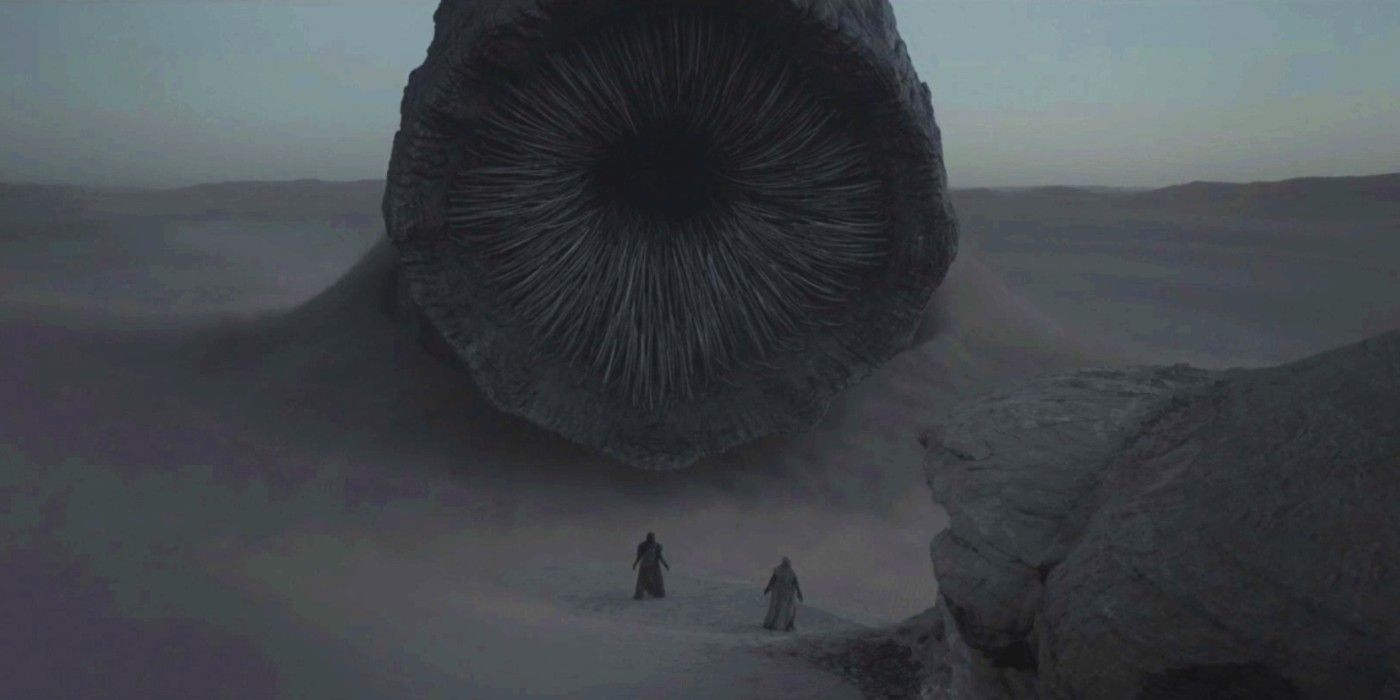In Denis Villeneuve's Dune, the sandworms only appear on-screen for a tiny, though terrifying, amount of time. The movie, coming in at 2 hours and 35 minutes, could have made the sandworms a more prominent part of Dune, or at least given them more time to shine. But Villeneuve's decision in Dune to limit their total appearance works wonders for the worms' terrifying impact on viewers.
Dune is primarily about the noble House Atreides, sent to the desert planet Arrakis as stewards of the planet after the Emperor of the Galactic Padishah Empire removed the Atreides' rivals, the Harkonens, from their position as stewards. Arrakis is the only place in the universe where "spice" is produced, a key component of space travel, making it a tremendously important resource over which much of the political drama of the film revolves. Moreover, the planet is inhabited by the Fremen, an indigenous group who live in the deep desert and share Arrakis's desert with the sandworms, which they call Shai-Hulud. The book about Arrakis from which protagonist Paul Atreides (Timothée Chalamet) learns from refers to the Fremen as dangerous, implicitly connecting the sandworms to that same risk of danger.
SCREENRANT VIDEO OF THE DAY
Surprisingly, despite how they influence Dune's mythology, the sandworms aren't on screen that much. The sandworms only appear for a total of a minute and a half on screen in the 2021 movie: a minuscule portion of the total runtime and by extension of the film itself. Nonetheless, they loom large in the background of the entire film and their existence sets much of the tone of the characters' experience on Arrakis. In the case of the sandworms, the "tell, don't show" approach works best.
Why Dune's Sandworms Are So Terrifying With Such Little Screen Time

The characters discuss the sandworms well before they show up on screen. Paul and his mother, Lady Jessica (Rebecca Ferguson), fly into Arrakis, and as they do so, Thufir Hawat (Stephen McKinley Henderson) explains that the Shield Wall is there to protect the city from sandstorms and sandworms, once again using an implicit connection to establish their danger. More explicitly, in the moments leading up to the first view of the sandworm, Dr. Liet Kynes (Sharon Duncan-Brewster), an Imperial Ecologist who has been on the planet for 20 years, also emphasizes their danger. When flying over the desert on the way to see how spice is harvested on Arrakis, she tells the characters on the ornithopter that they would not want to crash-land in the desert because "it's worm territory." These moments in Dune show the fear that the worms instill in many people, alerting the audience that they should be afraid, too.
Production design choices also help create the fear that the audience feels when the sandworms do finally appear. Quickly following the scene where Kynes warns the members of the Atreides expedition about the worms, the first sandworm shows up on screen. There's a massive cloud of sand barreling toward the spice harvester, one large enough for Kynes to make verbal note of it. According to executive producer Tanya Lapointe in the book The Art and Soul of Dune, the sandworm moves in an unexpected fashion: by plowing through sand dunes, destroying them in the process. Moreover, Villeneuve wanted the worm to have a "prehistoric presence," Lapointe explains. Once it actually appears, the Dune sandworm's massive size is finally revealed.
All of these choices help create a terrifying creature, even if the audience only actually sees the monster for a minute and half. The success of the sandworm's design in creating such terror goes to show that time on screen is not directly correlated to how scary a monster is. Great films, like Dune, that want to create terrifying monsters do not need to show the monster all that much: anticipation can be just as effective, if not more.
